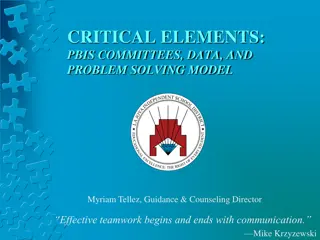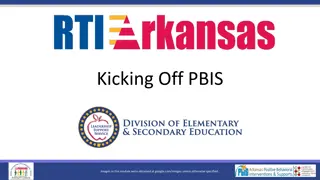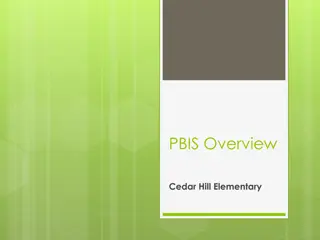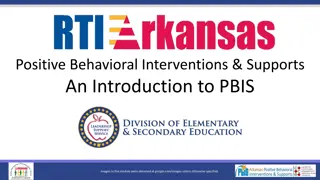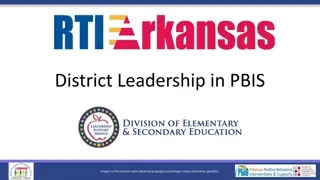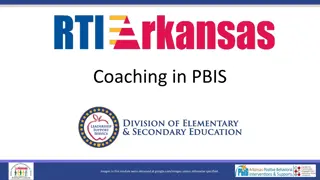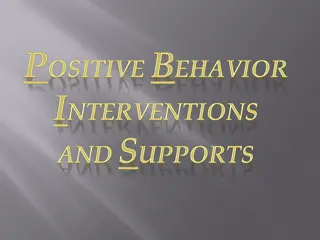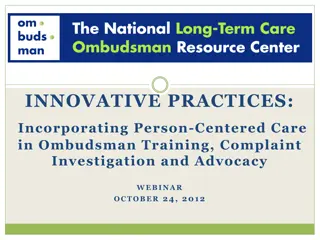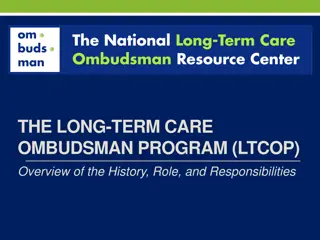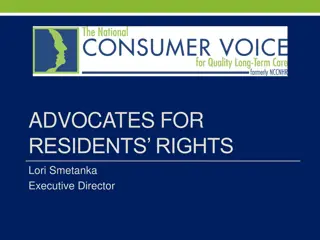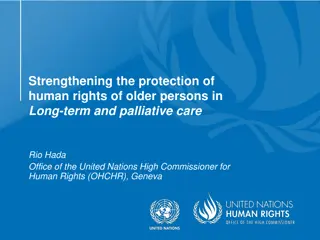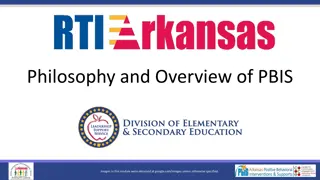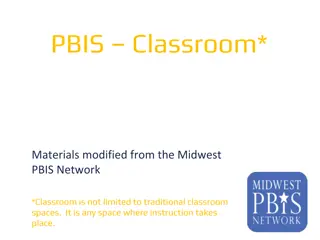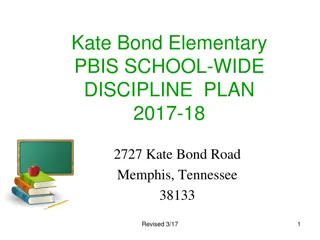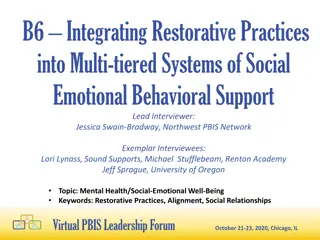Understanding Long-Term Sustainability of PBIS in Secure Care Settings
Exploring the challenges and strategies for sustaining Positive Behavioral Interventions and Supports (PBIS) in secure care environments, this content delves into the importance of fidelity, outcomes, and the influence of organizational culture. Key insights include sustaining practices, predictive categories for sustainability, and the essential aspects of implementation for long-term effectiveness.
- PBIS sustainability
- Secure care settings
- Fidelity
- Organizational culture
- Implementation effectiveness
Download Presentation

Please find below an Image/Link to download the presentation.
The content on the website is provided AS IS for your information and personal use only. It may not be sold, licensed, or shared on other websites without obtaining consent from the author. Download presentation by click this link. If you encounter any issues during the download, it is possible that the publisher has removed the file from their server.
E N D
Presentation Transcript
National PBIS Leadership Forum | October 3-4, 2019, Chicago, IL B8 - PBIS in Secure Care: Considerations for Effective Long-term Sustainability What Are We Getting Into? Presenter: Michael Turner Key Words: Juvenile Justice, Alternative Settings, Tier I
Whats Up with Long-Term Sustainability in Secure Care? We know PBIS can be implemented successfully, sometimes for years Secure care settings/Alternative settings Facility-wide models/School-wide models Implementation with fidelity is tied to favorable outcomes Fewer behavioral challenges Higher quality of life Yet sustainability doesn t happen automatically 4
What Leads a Program to Lose its Previous Gains? PBIS is still early in moving from traditional public schools to alternative settings Learning lessons along the way for long-term increased effectiveness Edgar Schein, Ph.D. Society of Sloan Fellows Professor of Management Emeritus, MIT Sloan School of Management Behavioral change is not culture change 5
Sustainability: Planning for Long- Term Implementation Approaches to this session: 1. Draw on PBIS experts Facility visits/relationships Follow up Tools developed for PBIS in secure care 2. Draw upon the field of organizational culture 3. Share historical user experience 6
Education and Treatment of Children (Vol. 42, No. 4, 2019) Sustaining PBIS in Secure Care for Juveniles Brenda K. Scheuermann, Texas State University C. Michael Nelson, University of Kentucky (emeritus) Indicates sustainability challenges despite good outcomes Recognizes significant differences in secure care from public schools Finds 3 general categories of practices predictive of sustainability Exploration and Early Implementation Monitoring and Enhancing Implementation Fidelity Data Collection and Evaluation 7
What is Sustainability? Important criteria offered by Hans and Weiss (2005) On-going implementation of an intervention, practice or program With fidelity to the core principles of the intervention Even after initial resources used to support training and implementation have been withdrawn Generally accepted standard in public schools (Corey and Horner, 2012) 3 to 5 years of successful implementation 8
Secure Care Largely Has Used Public Schools Tools for Guidelines Implementation Blueprint (including culturally relevant enhancements) School-Wide Evaluation Tool (SET) Team Implementation Checklist (TIC) Benchmarks of Quality (BoQ) School-Wide PBIS Tiered Fidelity Inventory (TFI) SWPBIS Tiered Fidelity Inventory Walk Through Tool 9
Differences in Operating Cultures Abound, e.g., . . . Cultural Theme/Artifact Hours of Operation Security Focus Types of youth Public Schools School Days; one shift Medium Normal range Secure Care Facilities 24*7*365; year round High Complex treatment and educational needs High Low to medium Narrow range Direct Supervision Social Interaction Allowable Activities/Materials Incentives/Rewards Authority Planning norms Low to medium High Wide range Wide range Relatively egalitarian Relatively proactive Narrow range Top down Relatively reactive 10
Add to Differences in Secure Care Huge Treatment Focus New Lenses Related to Child Development 11
One Tool Specifically for Secure Care PBIS is Available FW-PBIS Tiered Fidelity Inventory (version 2 draft) Recently posted at PBIS Center website, www.pbis.org In draft form ready for market testing Want feedback from users (comments, usability, suggestions, etc.) brenda@txstate.edu and/or mrt109@txstate.edu 12
A Few Organizational Culture Fundamentals (ala Edgar Schein, Ph.D.) 13
IF behavioral change produces better results Behavior change culture change AND IF lots of people share that perception AND IF people genuinely come to believe in their hearts and minds this is a better way of doing things AND IF that becomes sustainable over time THEN one can begin to speak about culture change
What is Organizational Culture? Sum total of everything learned in an organization s history related to the . . . Right way to operate (to solve problems, with habits of perception, thought and feeling) externally (mission, goals, strategies, working with public, boards, etc.) and internally (org charts, controls, rewards and incentives, how we relate to one another, etc.) Culture is always learned, never imposed. 15
~ Reality (External and Internal), If Culture 16
For Young Organizations, Change Primarily Moves Outward from Assumptions
For Mature Organizations, Change Primarily Moves Inward from Practices
Exploration and Early Implementation 20
Exploration and Early Implementation PBIS Team Composition Tiered Fidelity Inventory (v2 draft) 6-8 reps from youth care disciplines who can provide Behavior expertise In depth knowledge of youth Knowledge/authority involving facility operations Safety/Security expertise Youth voice Lessons Learned Team sizes for effectiveness Sacred cows discussions Egalitarian vs. top-down cultures Who are the most effective two-way communicators within and across disciplines? Well-intentioned is insufficient PBIS team needs authority or ready access to responsive authority 21
Exploration and Early Implementation Behavioral Expectations Tiered Fidelity Inventory (v2 draft) 6 or fewer overarching general expectations Expectations stated positively Specific behaviors defined for specific locations/activities in matrix Matrices posted in all relevant locations Lessons Learned Use a memorable acronym for general expectations Process to develop expectations needs broad input and skill to bring about consensus Something everyone can live with Get consensus on the language used in matrix Expect staff to use that language when instructing/reminding youth Youth generally meet expectations, whether high or low 22
Exploration and Early Implementation Staff Involvement Tiered Fidelity Inventory (v2 draft) Broad input on Expectations Reinforcements Definitions Consequences Lessons Learned Important nuance between broad input and PBIS team membership Need broad discussions on problem- solving and fidelity of practice Pay attention to language Make language deliberate Consistent with matrices Great brainstorming with broad input (rewards, incentives, etc.) Metrics development Quality of life and other good things Not just reduction of bad things Data analyses shared widely and regularly Input into problem-solving Broad participation in celebrations 23
Exploration and Early Implementation More Staff Involvement: Use Formal Processes for Input Weekly Monthly Quarterly Annually Behaviors of Focus Behavioral Matrices Language Assessment Ideas for Incentives and Consequences Data Metrics Data Results & Analyses Problem-solving Fidelity Assessments Other? Who? Where? How? 24
Exploration and Early Implementation More Staff Involvement: Integration of Work Approaches Underlying philosophy of what makes youth better? Focus Areas for Integration Policies and procedures Behavioral accountabililty How do youth grow and change? Curriculum development and training Do diverse activities cohere with the underlying philosophy? Job descriptions and evaluations Treatment 25
Exploration and Early Implementation Risks of Unintegrated Approaches Default becomes belief that curriculum is the change agent Undervalues relationships that offer context for change Unaligned belief systems within the agency (hodge-podge) Underdeveloped sense of collective meaning PBIS is experienced as yet another add-on responsibility Practices hinder fidelity and effectiveness of one another 26
Exploration and Early Implementation Integration: Curriculum Development and Training Critically review existing curricula for messages inconsistent with PBIS Involve trainers to check for understanding Be sensitive to areas of unlearning that need to occur Know your best advocates of traditional approaches Help them to identify contrasts in new approach and understand reasons Enlist their talents as leaders If they can t get on board, help them to be conscious and wary of undermining Encourage state of open mind If this isn t for them, assist them into other roles positively 27
Exploration and Early Implementation Integration: Treatment Treatment staff inclined to see PBIS as an unrelated add on unless framed helpfully Encourage holistic view of youth, i.e., everything s connected Consider spectrum of meaning behind behavioral infractions 28
Exploration and Early Implementation Example Reasons for Behavioral Acting Out Low expectations Confusion about proper behavior or expectations Not knowing how to meet expectations Underdeveloped locus of control, whether internal or external, in face of stimuli prompting a response Symbolic use of behavior to communicate non-verbally, whether conscious or not Testing limits to assess safety and/or supervisory staff What are staff skills/expectations? Do they care? Do they walk the talk? What s real? Functional perspective: to get or to avoid In service of meeting developmental milestones for autonomy, agency, voice, etc. Depressive or manic reactions with a biochemical basis 29
Exploration and Early Implementation Tier I Helps to Isolate Underlying Issues Low expectations Confusion about proper behavior or expectations Not knowing how to meet expectations Underdeveloped locus of control, whether internal or external, in face of stimuli prompting a response Intentional symbolic use of behavior to communicate non- verbally In service of meeting developmental milestones for autonomy, agency, voice, etc. Functional perspective: to get or to avoid Testing limits to assess safety and/or supervisory staff What are staff skills/expectations? Do they care? Do they walk the talk? What s real? Depressive or manic reactions with a biochemical basis 30
Exploration and Early Implementation Takes Some Behavioral Components Off the Table In service of meeting developmental milestones for autonomy, agency, voice, etc. Functional perspective: to get or to avoid Testing limits to assess safety and/or supervisory staff What are staff skills/expectations? Do they care? Do they walk the talk? What s real? Depressive or manic reactions with a biochemical basis Underdeveloped locus of control, whether internal or external, in face of stimuli prompting a response Intentional symbolic use of behavior to communicate non- verbally 31
Exploration and Early Implementation Incident Reduction Belies Reasons for Many Infractions Low expectations Confusion about proper behavior or expectations Not knowing how to meet expectations PBIS facilities reduce behavioral incidents by addressing these elements Raises bar on treatment program quality by Reducing distractions Helping teams to respond and intervene more effectively 32
Exploration and Early Implementation Teaching Expectations Tiered Fidelity Inventory (v2 draft) Expected academic and social behaviors taught directly to youth New admissions as well as long- standing residents Addresses all locations/activities on expectations matrix Lessons Learned Think through processes for new admissions vs. reviews and reminders for others Use examples and non-examples Use graphic posters for reference as applicable Caution re consistency Caution re frequent vs. useful reminders 33
Exploration and Early Implementation Youth Feedback and Acknowledgement Tiered Fidelity Inventory (v2 draft) One or more formal acknowledgement systems for rule following behavior Tied to overarching behavioral expectations Implemented across locations and activities Lessons Learned Danger of misinterpreting PBIS as a behavior modification program Healthy relationships are critical Staff creativity for problem-solving can be really helpful Tokens are more salient if youth physically handle them Tangible reminders of staff s personal value and appreciation for behavior Staff ability to see behaviors as functions and symbolic helps them to teach replacement behaviors 34
Monitoring and Enhancing Implementation Fidelity 35
Monitoring and Enhancing Implementation Fidelity PBIS Team Operating Procedures Tiered Fidelity Inventory (v2 draft) Meet at least monthly Use regular meeting format/agenda Keep meeting minutes Maintain current action plan Share meeting minutes with youth care staff Team members attend regularly and stay for entire meeting Lessons Learned How to take minutes matters Share drafts quickly, then post with corrections Track follow up activities in the minutes Be clear about who does what, when, where, etc. Agendas are helpful Basic scripts are helpful to start Review data prior to meeting Analyze for patterns, trends Open AND assigned responsibility 36
Monitoring and Enhancing Implementation Fidelity Staff Professional Development Tiered Fidelity Inventory (v2 draft) On-going, formally written and delivered processes Orient all staff on core PBIS principles Teaching facility wide expectations Acknowledging appropriate behavior Responding to major vs. minor infractions Requesting assistance Lessons Learned New hire training AND on-going training needed. They are different. Build capacity over time by teaching more about key behavioral principles Critically review pre-existing curriculum for fit Integration of new and old philosophies takes proactive attention Top leadership must understand Need for integration Behaviors must be unlearned Realistic timeline for new curriculum 37
Monitoring and Enhancing Implementation Fidelity Staff Feedback and Acknowledgement Tiered Fidelity Inventory (v2 draft) Formal acknowledgement systems to recognize staff who Teach and model expected behaviors Use rule matrices Use youth acknowledgement systems Use consequences for rule violations Lessons Learned One facility applied variation of the recommended approach Used PBIS as a teaching technique to role model for staff how it works Applied live Staff selected values that bring them to work Created behavioral expectations around values Managers gave monthly feedback Tracked progress with data 38
Monitoring and Enhancing Implementation Fidelity Access to Training, Coaching and Technical Assistance Tiered Fidelity Inventory (v2 draft) Sources to assist with building capacity are available in forms of Trainers Coaches Technical assistance providers Sources are available Inside the facility Outside the facility Lessons Learned Beware of behavior trainers in the market who espouse markedly different approaches from positive ones with multiple tiers of support Programs that develop internal coaches over time get better outcomes Be clear about staff competencies that coaches are trying to develop Be clear about competencies necessary to become a talented coach Support with a clear plan 39
Data Collection and Evaluation 40
Data Collection and Evaluation Data Collection and Data-based Decision Making Tiered Fidelity Inventory (v2 draft) Ready access to graphed behavior reports Analyses review data by Incident rates Days Times Locations People (Youth and Staff) Groups (e.g., dorms) Lessons Learned Be clear about two-fold purposes of data Fidelity assessment Measuring progress toward desired outcomes Seek out opportunities to practice data- based decision making Collecting data is much different from data-based decision making Cultivate and distribute this skill set 41
Map Opportunities to Practice Using Data 42
Leadership (broadly speaking) as Strategy Creating time and space for the work to flourish Tasks of embedding practices into organizational infrastructure Who?, What?, Where?, When?, How? . . . . Embedded practices, in turn, give opportunity to shape culture Fidelity is key for PBIS Culture driven by how leadership reacts to critical events Culture driven by what leadership does NOT say or react to 43
Contact Info Michael Turner mrt109@txstate.edu 44


